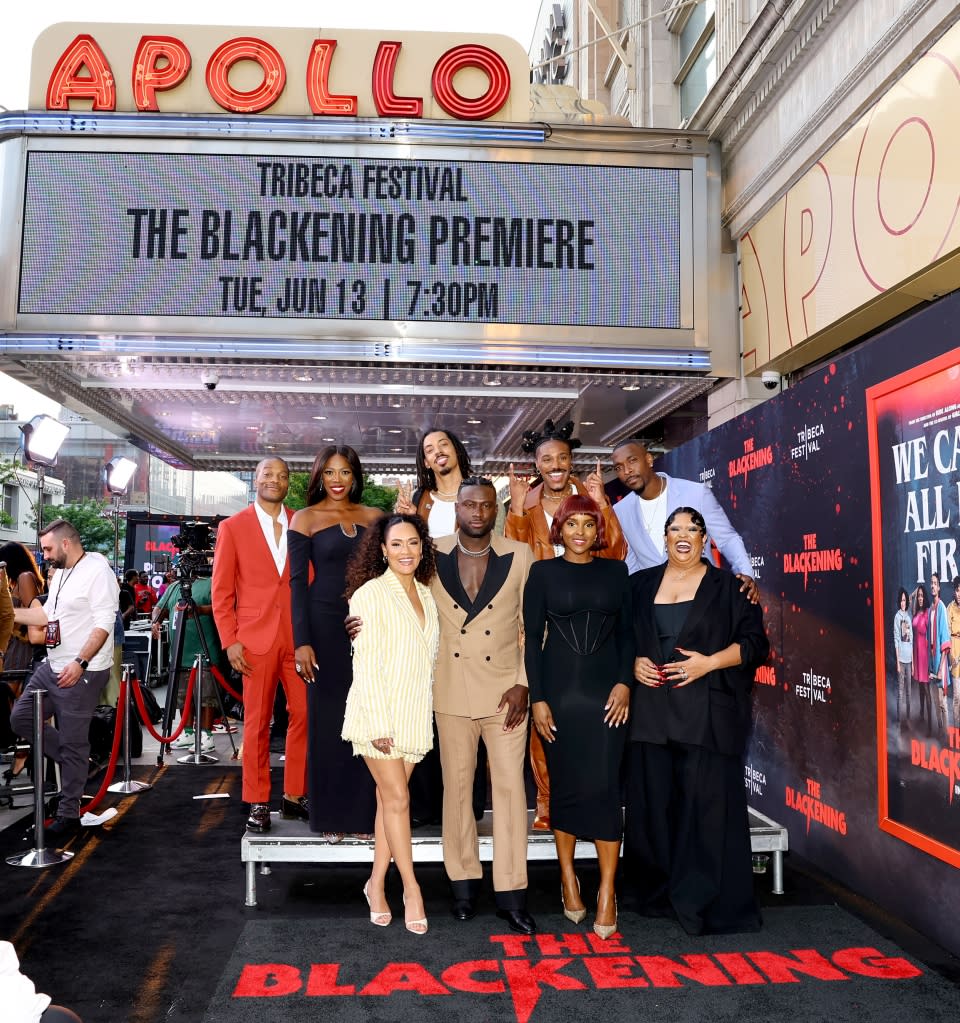‘The Blackening’ Mastermind Dewayne Perkins on Tackling Horror Movie (and the Gay BFF) Tropes and Future Plans: ‘It’s Giving Franchise’
- Oops!Something went wrong.Please try again later.
- Oops!Something went wrong.Please try again later.

SPOILER ALERT: This interview contains spoilers from “The Blackening,” now playing in theaters.
Dewayne Perkins is living his dream — though the $8 million box office tally for “The Blackening” wasn’t something he actually dreamed was possible.
More from Variety
'The Blackening' Review: The Rare Slasher Movie That's Also an Entertaining Social Satire
'Girls Trip 2' Reuniting Full Cast for Adventure in Ghana (EXCLUSIVE)
The microbudget (just $5 million) horror-comedy, co-written by and starring Perkins, follows a group of college friends who reunite to celebrate Juneteenth at a cabin in the woods, only to be hunted by a killer. But in a genre where the Black character usually dies first, what happens when all the characters are Black?
Perkins conceived the idea in 2016 as a sketch for his Chicago-based comedy troupe 3Peat. When it aired as a short on Comedy Central in 2018, the clip went viral and got the attention of Tracy Oliver, who — hot off the $140 million box office success of 2017’s “Girls Trip” — called with the idea that they could expand “The Blackening” into a feature film.
“I had no thought past living in the moment, like this is my task: make a sketch. I didn’t think that a movie was possible until Tracy called me,” Perkins tells Variety. “I said, ‘You know more than me, so let’s do this.’”
Fast forward to 2022, when the film’s director Tim Story (“Barbershop,” “Ride Along”) snuck Perkins into a test screening. Seeing “The Blackening” on the big screen for the first time was “pretty otherworldly,” Perkins says. During the process of making the movie, he’d fantasized about what it would be like to hear the audience absorb the movie exactly how he’d intended. “They’re answering the questions. They’re singing along. They’re yelling at the screen,” he explains. “And that’s exactly what it was.”
The creator was surreptitiously seated between an older Black couple and two Black girl friends, one of whom whispered to her friend that his character (also named Dewayne) was her favorite. “I was just like ‘Oh my God, they don’t even know I’m sitting right next to them!’” he recalls.
When it came time for his seatmates to fill out their scoresheets, Perkins peeked at their grades. “I was filling out my card like, ‘Umm… 10s across the board. What y’all writing over there?’” he laughs, adding: “That was the best moment of my career so far. It was a literal dream come true. And that dream is no longer a dream; it’s just a goal that was achieved.”
When Perkins sits down with Variety in early June, he’s just finished a day of interviews for the film’s press junket — his first experience with the rapid-fire interview style. “It was amazing!” he says, as we hustle through the bustling bar at the London Hotel in West Hollywood. “I truly was like, ‘This is too short, I need more time to talk to you.’”
Perkins was grouped with his co-stars X Mayo and Jermaine Fowler for his interviews. (The stellar ensemble cast also includes Grace Byers, Antoinette Robinson, Sinqua Walls, Melvin Gregg, Yvonne Orji and Jay Pharoah.) “I don’t know why they would put the three bad kids in the same room,” he adds, admitting that the trained improvisers had been cutting up. “It was just lots of bits. It is very hard to not, ‘Yes, and,’ because it’s so ingrained.”
To celebrate, we order a round of French 75s, his new favorite cocktail. “It’s like adult lemonade,” he says, grinning as we clink glasses, settling into a booth to discuss the process of adapting “The Blackening” into a feature, the film’s take on horror tropes and what he hopes comes next.

Perkins and Oliver co-wrote the script, bonding over their love of horror films like Wes Craven’s “Scream” as well as “Scary Movie,” Keenan Ivory Wayans’ classic spoof. “I like things that make me scared; it’s a good feeling,” Perkins chirps. “Like, make me jump!” From a young age, he was intrigued by human reaction to high stakes situations, so horror was the perfect outlet.
“I like the emotional journey that it takes you on, it’s almost like emotional manipulation and fear is such an innate human emotion,” Perkins says. “As a young kid, I feel like the stakes are always so high. You’d be like, ‘Yeah, life’s a horror movie. I’m a child with no power. This is terrifying!’”
Growing up as a Black gay kid on the south side of Chicago, authority figures like police and teachers could be “horrific characters” because they held a certain (and sometimes scary) power over him. Horror captured those emotions, with characters forced into situations where they felt powerless and emerging changed by the experience. “Watching people navigate fear — because I had so much of it — fascinated me,” he explains. “And as I got older, I learned how to deal with that [fear] myself.”
Personally, Perkins learned to overcome his fears academically, using his critical thinking skills to dissect his emotions and recognize that what he feared wasn’t always the truth of the situation. “My counter is to know more so I have space and knowledge to know how to regulate,” he says.
Professionally, he embraced it. “Scream” was particularly influential on Perkins, who marveled at the film’s self-aware nature and meta jokes. It was illuminating to see Craven’s commentary on the horror genre and recognize the patterns and tropes that the film deconstructs. “It spoke to the idea that horror movies are art,” Perkins says. And, even though there weren’t any Black characters in the first “Scream” — and, in other similar films, they rarely survived to midpoint, let alone the end credits — the pull of the genre’s possibilities transcended the lack of representation. And now he’s in charge of filling in that racial blank.
“‘The Blackening’ could not have been made unless I consumed ‘Scary Movie’ and ‘Scream,’” he says. “This is a collection of everything that I absorbed. And allowing the art that has influenced me to be a part of what I’m making feels reverential.”
In expanding “The Blackening” from one scene to a feature-length runtime, Perkins and Oliver focused the sketch — where the group of friends debate over which one is the Blackest, and therefore the first to die — at the core of their story so that the throughline between the projects was clear. (In the film, the Blackface killer quizzes the group on Black facts with a wildly racist-looking board game.) Then, they expanded outward, building the characters’ backstories and relationships to one another and using them to inform the plot.
The film’s characters are all named for the members of 3Peat — “Friendship is very important to me,” Perkins says of crediting his crew — with Perkins playing “Dewayne,” who can be characterized as “the gay best friend.”
Perkins kept his name in the movie for two reasons: “It was like, ‘No one can play this but me,’” he jokes, describing the movie character as a “heightened” version of himself.
The other reason was more personal. “I grew up having a very bad stutter — I still have it now. I’ve just had years and years of speech therapies,” he explains. “But in certain environments, one of the triggers of my speech impediment is saying my name. For some reason, the sounds of my name are sometimes hard to say. And I thought, ‘If people know my name, I have to say it less,’ so it’s helpful tool for me to make my life easier.”
Perkins and Oliver studied common horror movie tropes in order to ensure viewers had enough to grab onto to form an opinion, but the archetypes they presented also had to be specific to Black folks (the activist, the maybe-thug, the native African, the corny dude, the mixed-race person, etc.).
“We’re forcing people to judge the way that they think,” Perkins says, with a knowing laugh. “As a Black queer man, literally most of my existence is counteracting the perception of people.”
It was important to nail down how people would perceive these characters at the beginning of the film and then subvert that idea. “By the end of the movie, each character is a fully-developed character taking what you thought was stereotype or a trope, and forcing the audience to move outside of that, expanding that box of what Black people can do and be,” he explains.
“The Blackening” explores the way Black people experience horror differently. It’s asking the question: “What does it mean to live a life that has always forced you to learn how to survive?” Perkins says. “In these environments, you don’t lose your life experience — that only helps you. That is why Black people be yelling at movies. Because they’re like, ‘Oh I wouldn’t do that, because I’ve been in situations where I know that’s dumb.’ Having these characters be able to live in that fully was one of the main goals.”
Perkins was particularly invested in deconstructing the “gay best friend” trope, expanding the limitations he’s experienced throughout his career as an actor and comedian. A 2020 Variety 10 Comics to Watch honoree, Perkins earned a Primetime Emmy nomination for his work on “The Amber Ruffin Show” in the writing for a variety series category, with credits including “The Upshaws,” “Brooklyn Nine-Nine” and the “Saved by the Bell” revival.
“I was an actor first, and the roles in which I was asked or given were never roles I felt showcased me and my life. So, being able to create a character that not only pushes representation for myself, but many other queer Black people was fucking great,” he says, underscoring his point. “As a gay man, I can also fight a killer. I can still be a hero. there are not many instances where I’ve seen gay Black men be heroes.” And the representation on-screen mirrors his potential behind the camera. “I wrote this. I’m in it. I’m showing you firsthand all the ways in which I exist and people like me exist. Get with it.”
As far as Dewayne’s character arc is concerned, Perkins wanted to put platonic friendship under a microscope, since movies often prioritize romantic love instead. The subplot focuses on Dewayne’s relationship with his bestie Lisa (Robinson) and the reveal that her cheating ex Nnamdi (Walls) is joining the friends at the cabin. Of course, Dewayne feels totally betrayed after spending so much time and energy drying Lisa’s tears.
“For somebody who feels like they gave you so much, to essentially be deprioritized because of the man who mistreated you, having that conversation in the film, and giving space to gay best friends was very important to me,” he says. “Often, they’re not allowed to discuss what that friendship means.”
In true horror movie fashion, Dewayne and Lisa’s friendship drama comes to a head at a truly inopportune moment — as they argue about their feelings with the Blackface killer just inches away and poised to strike. It’s one of those finely-tuned moments that toes the line between thriller and comedy and, when Perkins and Oliver turned their finished script over to Story, he was so impressed by the vision that he signed on to direct.
“He said, ‘I’ve not seen a script that has made me laugh out loud reading it, and I don’t want anybody to fuck this up,’” Perkins recalls. That feedback meant the world. That Story — whose films have made more than $1 billion at the box office — stayed on to shepherd the project ensured it stayed on track. “That’s why the movie is as Black as it is,” Perkins says.

Perkins mentions that he was particularly conscious of the moviegoing experience when they were crafting the film. The goal, he says was, “If I was consuming this, what would make me leave the theater in the best spirit.”
That’s why, for example, the killer’s weapon of choice was a crossbow. He thought, “What is something that can instill fear and harm [someone], without being visually traumatic? Because I don’t want Black people, in particular, to come and see this movie and be triggered. That’s why there’s not a lot of guns.”
Instead, when a character is shot with an arrow, it’s shocking, but it’s also funny. “You’re not seeing his brains blown out,” Perkins says. “It gave enough of what we needed to convey the horror without leaning too far into what we didn’t want.”
Similarly, the film ends with the survivors — spoiler alert: Dewayne makes it to the end of the movie — weighing their options about what to do next. They can’t call the cops — obviously — because how will they explain all the dead people (including some white folks).
“It was very important to me to do a bit where there’s credits and the scene just keeps going because this is not an easy answer, like they’re gonna have to sit and figure it out,” Perkins notes.
They light up a joint and Dewayne comes up with the perfect solution: he calls the fire department and changes his outfit in case they end up on the news. “I’m the only character that has three costume changes,” Perkins points out.
The final shot shows the fire department arriving just off camera and the group gets sprayed with a high-powered firehose. It was Perkins’ idea to end the movie with the feeling that they’d figured it out, “And then it’s like ‘Ugh, there’s the hand of oppression again!’” he exclaims.
Perkins is drawn to absurdity. He loves comedy that heightens into satire and that shot — which evokes the tactics used in opposition to the Civil Rights marches of the ’60s and the protests of today — threads a very specific needle.
“Being able to speak about the relationship of Black people and police without it being heavy and traumatic, but being like, ‘Oh, no, this is like a thing that we have to deal with,’” he explains. “Like, ‘Oh, damn! Yeah, if y’all just murdered a couple of people, what is gon’ happen?’”

The MRC Films-produced project made its world premiere as a midnight selection at TIFF in September where it enjoyed a boisterous reception from the crowd, with Lionsgate winning a bidding war to acquire the rights. The studio set “The Blackening” for a June 16 theatrical release, just in time for Juneteenth.
The press tour for the film included screenings at HBCU’s across the country as well as festival stops at the Tribeca Festival in New York (a massive celebration at the Apollo Theatre, with a Q&A moderated by “Nope” star Keke Palmer, who gets a shoutout in the movie), then to Miami for the American Black Film Festival and Los Angeles for CultureCon. “It’s been incredibly positive, in a way that I did not anticipate – and not because I didn’t think that it will be positive,” he says of the public reception. “I just have tried to be very regulated.”
That’s something he learned to do on set. On his first day of shooting, Perkins showed up composed to such an extreme that his scene partners Robertson and Grace Byer asked, “Why are you so calm?” Of course, Perkins was “freaking out internally,” but he was focused on bringing his best self to set. “I was just nervous,” he admits. “Because there’s just so many people on a movie set, and knowing the position that I had, I just wanted things to go well. I want the cast to like me; I want the crew to like me.”
Once they wrapped the scene and headed back to base camp, Robertson knocked on his trailer door. “I see you trying to be real calm,” she told him. “Don’t do that. It’s not worth it. Live in this moment in a way that really allows you the freedom to enjoy it.”
Amid the dizzying media blitz, Perkins put that advice to good use in order to enjoy each moment of the rollout instead of worrying (unnecessarily) about the box office. It’s been particularly “filling” to experience the way that the film has resonated outside his bubble of Chicago, New York and Los Angeles.
“Seeing how much this story feels universal, even outside of race, outside of age, gender, it reminded me that people enjoy joy,” Perkins explains. “People being like, ‘Oh, we have to see this as a group’ and creating a communal experience. This tour has just kind of weirdly has given me a brighter point of view on humanity.” The cast and crew screening was particularly emotional. “Having people tell me, ‘This movie got me into the union, like you changed my life.’ This movie so much bigger than me now.”
And Perkins would like to continue “The Blackening” ride. “In my mind, it’s giving franchise,” he quips. “I’m not sure who’s going to do it but somebody’s gonna make some more.”
He’s leaning toward a “Scary Movie”-esque anthology versus the “Knives Out” style with a new cast for each mystery. “Same group, sprinkle in some new people,” he says. “I feel like we’ve got something good, and I love the dynamic, but fresh blood always turns things up a little bit.”
In some sense, Perkins is building toward becoming the next Craven or Jordan Peele. Like those horror masterminds, he wants people to know what to expect from a Dewayne Perkins film, whether it be thrills and chills or any other genre.
“I’ve been trying to convince everybody in Hollywood that I’m the ideas man,” he says, laughing, but not joking. He’s keen on writing a rom-com and a superhero movie. “Similar to how I feel about horror, I feel that way about many genres, and I want to be able to present my point of view on those.”
He explains: “As a gay man, I want to show love from my perspective. When we talk about rom-coms or just gay men, the movie that comes up often is ‘Moonlight.’ Like, yes, I love ‘Moonlight,’ but that shouldn’t be the only movie that comes up; we have to expand the lexicon of what Black queer love can look like.”
And now that he’s primed to conquer Hollywood, he hopes other kids growing up on Chicago’s South Side will dream bigger than he did.
“I thought the bar was so much higher, that it’s almost impossible for somebody like me to experience this,” Perkins says. “Then to get here, it’s like, ‘I took notes and I’m willing to give this information to anybody.’ This should be accessible. We should not feel that we have to be ‘special’ to be able to experience a career in the arts. That’s my high horse.”
Best of Variety
'House of the Dragon': Every Character and What You Need to Know About the 'Game of Thrones' Prequel
25 Groundbreaking Female Directors: From Alice Guy to Chloé Zhao
Sign up for Variety’s Newsletter. For the latest news, follow us on Facebook, Twitter, and Instagram.

